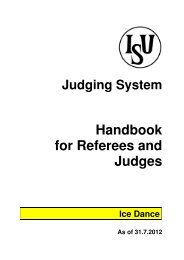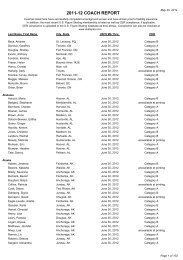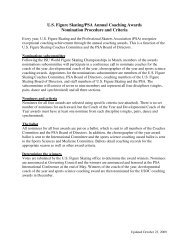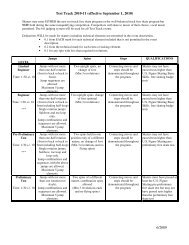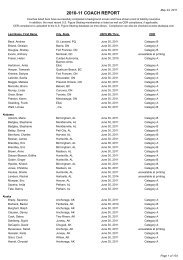The Female Athlete Triad - US Figure Skating
The Female Athlete Triad - US Figure Skating
The Female Athlete Triad - US Figure Skating
You also want an ePaper? Increase the reach of your titles
YUMPU automatically turns print PDFs into web optimized ePapers that Google loves.
SPECIAL COMMUNICATIONSPOSITION STAND<strong>The</strong> <strong>Female</strong> <strong>Athlete</strong> <strong>Triad</strong>This pronouncement was written for the American College ofSports Medicine by Aurelia Nattiv, M.D., FACSM (Chair); Anne B.Loucks, Ph.D., FACSM; Melinda M. Manore, Ph.D., R.D., FACSM;Charlotte F. Sanborn, Ph.D., FACSM; Jorunn Sundgot-Borgen,Ph.D.; and Michelle P. Warren, M.D.SUMMARY<strong>The</strong> female athlete triad (<strong>Triad</strong>) refers to the interrelationships among energyavailability, menstrual function, and bone mineral density, which may haveclinical manifestations including eating disorders, functional hypothalamicamenorrhea, and osteoporosis. With proper nutrition, these same relationshipspromote robust health. <strong>Athlete</strong>s are distributed along a spectrum betweenhealth and disease, and those at the pathological end may not exhibit all theseclinical conditions simultaneously. Energy availability is defined as dietaryenergy intake minus exercise energy expenditure. Low energy availabilityappears to be the factor that impairs reproductive and skeletal health in the<strong>Triad</strong>, and it may be inadvertent, intentional, or psychopathological. Mosteffects appear to occur below an energy availability of 30 kcalIkg j1 of fatfreemass per day. Restrictive eating behaviors practiced by girls and womenin sports or physical activities that emphasize leanness are of special concern.For prevention and early intervention, education of athletes, parents, coaches,trainers, judges, and administrators is a priority. <strong>Athlete</strong>s should be assessedfor the <strong>Triad</strong> at the preparticipation physical and/or annual health screeningexam, and whenever an athlete presents with any of the <strong>Triad</strong>’s clinicalconditions. Sport administrators should also consider rule changes todiscourage unhealthy weight loss practices. A multidisciplinary treatmentteam should include a physician or other health-care professional, a registereddietitian, and, for athletes with eating disorders, a mental health practitioner.Additional valuable team members may include a certified athletic trainer, anexercise physiologist, and the athlete’s coach, parents and other familymembers. <strong>The</strong> first aim of treatment for any <strong>Triad</strong> component is to increaseenergy availability by increasing energy intake and/or reducing exerciseenergy expenditure. Nutrition counseling and monitoring are sufficientinterventions for many athletes, but eating disorders warrant psychotherapy.<strong>Athlete</strong>s with eating disorders should be required to meet established criteriato continue exercising, and their training and competition may need to bemodified. No pharmacological agent adequately restores bone loss or correctsmetabolic abnormalities that impair health and performance in athletes withfunctional hypothalamic amenorrhea.INTRODUCTIONBecause the benefits of exercise far outweigh the risks, theAmerican College of Sports Medicine (ACSM) encourages allgirls and women to participate in physical activities and sports.In 1992, however, an association of disordered eating,amenorrhea, and osteoporosis seen in activities that emphasize0195-9131/07/3910-1867/0MEDICINE & SCIENCE IN SPORTS & EXERCISE ÒCopyright Ó 2007 by the American College of Sports MedicineDOI: 10.1249/mss.0b013e318149f111a lean physique was recognized as the female athlete triad(<strong>Triad</strong>) (148,215). This Position Stand replaces the 1997ACSM Position Stand (155), updates our understanding, andmakes new recommendations for screening, diagnosis,prevention, and treatment of the <strong>Triad</strong>.EVIDENCE CLASSIFICATIONThis Position Stand presents clinical recommendations forguiding primary care (Table 1). We used criteria proposed bythe American Academy of Family Physicians (52) forevaluating the strength of scientific evidence supportingthese clinical recommendations. <strong>The</strong>se criteria categorize thestrength of scientific evidence as follows: A, consistent andgood-quality evidence for clinical outcomes on mortality,morbidity, symptoms, cost, and quality of life; B, inconsistentor limited quality evidence for these same clinical outcomes;and C, evidence on biochemical, histological, physiologicaland pathophysiological outcomes, which include hormoneconcentrations, bone mineral density (BMD), and asymptomaticmenstrual disorders such as short luteal phase andanovulation; and evidence based on case studies, consensus,usual practice, and opinion. To avoid misunderstanding, thisPosition Stand differentiates between two subcategories ofevidence: C-1, evidence based on biochemical, histological,physiological, and pathophysiological outcomes; and C-2,evidence based on case studies, consensus, usual practice,and opinion. This Position Stand also presents evidencestatements about the current state of knowledge (Table 1).Although the clinical recommendation criteria were notdeveloped for evaluating evidence supporting statementsabout the current state of knowledge (52), we used thesesame criteria to evaluate this evidence, as well.THREE INTERRELATED SPECTRUMSLow energy availability (with or without eating disorders),amenorrhea, and osteoporosis, alone or in combination, posesignificant health risks to physically active girls and women.<strong>The</strong> potentially irreversible consequences of these clinicalconditions emphasize the critical need for prevention, earlydiagnosis, and treatment. Each clinical condition is nowSPECIAL COMMUNICATIONS1867Copyright @ 2007by the American College of Sports Medicine. Unauthorized reproduction of this article is prohibited.
TABLE 1. Strength of evidence taxonomy.Grade Reason for CEvidence StatementsSevere undernutrition impairs reproductive and skeletal health.ADE/ED and amenorrhea occur more frequently in sports that emphasize leanness.AOn average, BMD is lower in amenorrheic than in eumenorrheic athletes. C 1Menstrual irregularities and low BMD increase stress fracture risk.AIn FHA, increases in BMD are more closely associated with increases in weight than with OCP/HRT administration. C 1Clinical Recommendations for Screening and DiagnosisScreening for the <strong>Triad</strong> should occur at the preparticipation exam or annual health screening exam. C 2<strong>Athlete</strong>s with one component of the <strong>Triad</strong> should be assessed for the others. C 2<strong>Athlete</strong>s with disordered eating should be referred to a mental health practitioner for evaluation, diagnosis and treatment. C 2To diagnose FHA, other causes of amenorrhea must be excluded.BBMD should be assessed after a stress or low impact fracture and after a total of 6 months of amenorrhea, oligomenorrhea, or DE/ED. C 2Clinical Recommendations for TreatmentMultidisciplinary treatment for the <strong>Triad</strong> disorders should include a physician (or other health-care professional),C 2a registered dietitian, and, for athletes with DE/ED, a mental health practitioner.<strong>The</strong> first aim of treatment is to increase energy availability by increasing energy intake and/or reducing energy expenditure.C 1<strong>Athlete</strong>s without DE/ED should be referred for nutritional counseling.<strong>Athlete</strong>s practicing restrictive eating behaviors should be counseled that increases in body weight may be necessary to increase BMD. C 1Treatment for DE/ED includes nutritional counseling and individual psychotherapy. Cognitive behavioral, group therapy and/orBfamily therapy may also be used.<strong>Athlete</strong>s with DE/ED who do not comply with treatment may need to be restricted from training and competition. C 2OCP should be considered in an athlete with FHA over age 16 if BMD is decreasing with nonpharmacological management,C 2despite adequate nutrition and body weight.Evidence Categories: A—Consistent, good-quality evidence on morbidity, mortality, symptom improvement, cost reduction, and quality of life. B—Inconsistent or limited qualityevidence on the same outcomes. C—Other evidence: 1—Evidence on biochemical, histological, physiological and pathophysiological outcomes, which include hormoneconcentrations, bone mineral density, and asymptomatic menstrual disorders such as short luteal phase and anovulation; 2—case studies, consensus, usual practice, opinion.Definitions: DE/ED—disordered eating or eating disorders; BMD—bone mineral density; FHA—functional hypothalamic amenorrhea; OCP—oral contraceptive pills; HRT—hormonereplacement therapy.SPECIAL COMMUNICATIONSunderstood to comprise the pathological end of a spectrum ofinterrelated subclinical conditions between health and disease.<strong>Figure</strong> 1 illustrates the full range of the <strong>Triad</strong>. A glossaryof terms pertaining to the <strong>Triad</strong> appears in Table 2.<strong>The</strong> goal of ACSM is for every girl and woman’sphysical condition to be coincident with the upper rightcorner of <strong>Figure</strong> 1, which represents the healthy athlete whoadjusts her dietary energy intake to compensate for exerciseenergy expenditure. Thick arrows in this triangle indicatethat energy availability promotes bone health and developmentindirectly by preserving eumenorrhea (Table 2) andestrogen production that restrains bone resorption, anddirectly by stimulating production of hormones thatpromote bone formation. As a result, BMD is often aboveaverage for the athlete’s age.FIGURE 1—<strong>Female</strong> athlete triad. <strong>The</strong> spectrums of energy availability,menstrual function, and bone mineral density along which femaleathletes are distributed (narrow arrows). An athlete’s condition movesalong each spectrum at a different rate, in one direction or the other,according to her diet and exercise habits. Energy availability, defined asdietary energy intake minus exercise energy expenditure, affects bonemineral density both directly via metabolic hormones and indirectly viaeffects on menstrual function and thereby estrogen (thick arrows).<strong>The</strong> triangle in the lower left corner of <strong>Figure</strong> 1 representsthe unhealthy condition of athletes who exercise for prolongedperiods without increasing dietary energy intake, who severelyrestrict their diet, or who have clinical eating disorders. Thickarrows in this triangle indicate that low energy availabilityimpairs bone health and development indirectly by inducingamenorrhea and removing estrogen’s restraint on boneresorption, and directly by suppressing the hormones thatpromote bone formation. Bone mineral accrual has slowed orreversed for so long that BMD is below average for age, andone or more stress fractures may have occurred.<strong>The</strong> narrow arrows in <strong>Figure</strong> 1 indicate the spectrums ofintermediate levels of energy availability, menstrual status,and BMD where other athletes’ health status may bedistributed. Moderately or recurrently reduced energy availabilitymay induce subclinical menstrual disorders and lessseverely suppress estrogen and metabolic hormones, andsufficient time may not yet have passed for these athletes tofall far behind their age group in BMD. Energy availability,menstrual status, and BMD move along these spectrums inone direction or the other at different rates according to anathlete’s diet and exercise habits. Energy availability canchange in a day, but an effect on menstrual status may notbecome evident for a month or more, and an effect on BMDmay not be detectable for a year.Energy AvailabilityThis Position Stand refers to a spectrum of energyavailability from optimal energy availability to low energyavailability with or without an eating disorder. Defined asdietary energy intake minus exercise energy expenditure,energy availability is the amount of dietary energy remaining1868 Official Journal of the American College of Sports Medicinehttp://www.acsm-msse.orgCopyright @ 2007by the American College of Sports Medicine. Unauthorized reproduction of this article is prohibited.
TABLE 2. Glossary of terms pertaining to the female athlete triad.<strong>Female</strong> athlete triad relationships among energy availability, menstrual function, and BMD that may have clinical manifestations including eating disorders,functional hypothalamic amenorrhea, and osteoporosis.Energy availability (EA) dietary energy intake (EI) minus exercise energy expenditure (EEE) normalized to fat-free mass (FFM), i.e., EA = (EI j EEE)/FFM, in units ofkilocalories or kilojoules per kilogram of fat-free mass. For example, for a dietary energy intake of 2000 kcalId j1 , an exercise energyexpenditure of 600 kcalId j1 , and a fat-free mass of 51 kg, EA = (2000 j 600)/51 = 27.5 kcalIkg j1 FFMId j1 .Exercise energy expenditure strictly, the energy expended during exercise training in excess of the energy that would have been expended in nonexercise activity during thesame time interval. Neglecting the adjustment for non-exercise activity causes EA to be underestimated by a few kcalIkg j1 FFMId j1 , which is anegligible error for most purposes.Disordered eatingvarious abnormal eating behaviors, including restrictive eating, fasting, frequently skipped meals, diet pills, laxatives, diuretics, enemas,overeating, binge-eating and then purging (vomiting).Eating disordera clinical mental disorder defined by DSM-IV (8) and characterized by abnormal eating behaviors, an irrational fear of gaining weight, and falsebeliefs about eating, weight, and shape.Eumenorrheamenstrual cycles at intervals near the median interval for young adult women. In young adult women, menstrual cycles recur at a median intervalof 28 d that varies with a standard deviation of 7 d.Oligomenorrheamenstrual cycles at intervals longer than 35 d, i.e., greater than the median plus one standard deviation.Luteal suppressiona menstrual cycle with a luteal phase shorter than 11 d in length or with a low concentration of progesterone.Anovulationa menstrual cycle without ovulation.Amenorrhea absence of menstrual cycles for more than 90 d.Low BMD*bone mineral density Z-score** between j1.0 and j2.0.Osteoporosis*bone mineral density Z-score** ej2.0 together with secondary risk factors for fracture (e.g., undernutrition, hypoestrogenism, prior fractures).* <strong>The</strong>se definitions apply to physically active and athletic premenopausal women and children.**AZ-score compares the bone mineral density of an individual to those of age, race, and sex-matched controls.for other body functions after exercise training. When energyavailability is too low, physiological mechanisms reduce theamount of energy used for cellular maintenance, thermoregulation,growth, and reproduction (199). This compensationtends to restore energy balance and promote survival, butimpairs health. Stable body weight in amenorrheic athletes(44,93,127,145,150,209) suggests that energy balance can berestored while energy availability is low.Some athletes reduce energy availability by increasingexercise energy expenditure more than energy intake.Others reduce energy intake more than exercise energyexpenditure. Some practice abnormal eating behaviors suchas fasting, binge-eating and purging, or use diet pills,laxatives, diuretics, and enemas (5,17,18,92,182,183).Some athletes also have eating disorders, which areclinical mental disorders often accompanied by otherpsychiatric illnesses (26,97). Anorexia nervosa is an eatingdisorder characterized by restrictive eating in which theindividual views herself as overweight and is afraid ofgaining weight even though she is at least 15% belowexpected weight for age and height. Amenorrhea is adiagnostic criterion for anorexia nervosa (5). Anorexianervosa appears in restricting and purging subtypes. Bulimianervosa is an eating disorder in which affected individuals,usually in the normal weight range, repeat a cycle ofovereating or binge-eating and then purging or othercompensatory behaviors such as fasting or excessive exercise(5). Individuals who do not meet all criteria for anorexianervosa or bulimia nervosa are classified as having an eatingdisorder not otherwise specified (ED-NOS). An individualmay meet all anorexia nervosa criteria except that she hasregular menses, or all bulimia nervosa criteria except that shebinges and purges less than twice per week (5).Menstrual FunctionThis Position Stand refers to a spectrum of menstrual functionranging from eumenorrhea to amenorrhea (Fig. 1). Within thisrange, oligomenorrhea is recognized by menstrual cyclesoccurring at intervals longer than 35 d, but luteal deficiencyand anovulation have no perceptible symptoms (129,197).Because menstrual cycles longer than 90 d are rare(197), amenorrhea is defined as the absence of menstrualcycles lasting more than three months (9). Amenorrheabeginning after menarche is called secondary amenorrhea.Primary amenorrhea refers to a delay in the age ofmenarche. Because menarche is occurring earlier, thedefining age for primary amenorrhea was recently reducedfrom 16 to 15 yr (9). Animal research clearly demonstratesthat energy deficiency before puberty suppresses growthand delays sexual development (174). Many retrospectivesurveys have established that menarche often occurs laterin athletes than in nonathletes, but such surveys areinherently biased (178). Only one prospective observationalstudy has attempted to relate the age of menarche toathletic training (200). <strong>The</strong> authors found that menarcheoccurred at a later age in ballet dancers but at the sameheight and weight as in nondancers.Bone Mineral DensityThis Position Stand refers to a spectrum of BMD rangingfrom optimal bone health to osteoporosis (Fig. 1). Osteoporosisis defined as ‘‘a skeletal disorder characterized bycompromised bone strength predisposing a person to anincreased risk of fracture’’ (146). Bone strength and the riskof fracture depend on the density and internal structure ofbone mineral and on the quality of bone protein, which mayexplain why one person suffers fractures while another withthe same BMD does not. Although BMD is only one aspectof bone strength, this Position Stand focuses on BMDbecause screening and diagnosis of osteoporosis are stillbased on BMD. Osteoporosis is not always caused byaccelerated bone mineral loss in adulthood. It may also becaused by not accumulating optimal BMD during childhoodand adolescence (146).SPECIAL COMMUNICATIONSTHE FEMALE ATHLETE TRIAD Medicine & Science in Sports & Exercise d1869Copyright @ 2007by the American College of Sports Medicine. Unauthorized reproduction of this article is prohibited.
Menstrual irregularities and low BMD increase stressfracture risk. Evidence category A.EPIDEMIOLOGYPrevalenceIn athletes, the prevalence of disordered eating, menstrualdisorders, low BMD and stress fractures varies widely(31,151,161). <strong>The</strong> prevalence of inadvertent low energyavailability without disordered eating or eating disorders isunknown.Many studies of the prevalence of disordered eating andeating disorders in athletes have yielded unreliable resultsdue to nonstandard diagnostic procedures, small samplesizes, absent or inappropriate control groups, inadequatestatistics, and heterogeneity in the type and level of theathletes studied (30). Only two large, well-controlled studieshave diagnosed clinical eating disorders according to theDiagnostic and Statistical Manual of Mental Disorders (8)to obtain unbiased and reliable estimates of the prevalenceof eating disorders in elite female athletes in different typesof sports (31,186). One found eating disorders in 31% ofelite female athletes in ‘‘thin-build’’ sports compared to5.5% of the control population (31). <strong>The</strong> other found that25% of female elite athletes in endurance sports, aestheticsports, and weight-class sports had clinical eating disorderscompared to 9% of the general population (186). A smallstudy of collegiate gymnasts (N = 42) found a prevalence ofdisordered eating behaviors as high as 62% (170). A largerstudy of collegiate gymnasts (N = 218) showed specificweight control behaviors included binge eating (33% Qonce a week), exercise for the purpose of burning calories(57% Q 2hId j1 ), and fasting or strict dieting (28% Q 4times in the past year). However, induced vomiting and theuse of diuretics and/or laxatives were rare events (158).<strong>The</strong> prevalence of secondary amenorrhea, long known tovary widely with sport, age, training volume and body weight(161),hasbeenreportedinsmallstudiestobeashighas69%in dancers (1) and 65% in long-distance runners (51) comparedto 2–5% in large studies of the general population(11,159,175). Within distance runners, prevalence of amenorrheaincreased from 3% to 60% as training mileage increasedfrom G13 to 9113 kmIwk j1 while their body weightsdecreased from 960 to G50 kg (172). Prevalence of secondaryamenorrhea is higher (67%) in female runners less than 15 yrof gynecological age compared to older women (9%) (13).<strong>The</strong> prevalence of primary amenorrhea is less than 1% in thegeneral population (33) and more than 22% in cheerleading,diving and gymnastics (18). Subclinical menstrual disorderstypify both highly trained (121) and recreational (42,53)eumenorrheic athletes: luteal deficiency or anovulation wasfound in 78% of eumenorrheic recreational runners in at leastone menstrual cycle out of three (42).Low BMD has been associated with disordered eatingeven in eumenorrheic athletes (34). BMD is lower inamenorrheic athletes than in eumenorrheic athletes(46,127,143,151,162). A systematic review of studies thatemployed WHO T-scores for diagnosis, found prevalence ofosteopenia (T-score between j1.0 and j2.5) ranging from22% to 50% and prevalence of osteoporosis (T-score ej2.5) ranging from 0% to 13% in female athletes (104)compared to 12% and 2.3% expected in a normalpopulation distribution.Only three studies of female athletes have investigatedthe simultaneous occurrence of disordered eating, menstrualdisorders and low BMD according to ISCD criteria(17,152,191). Only one diagnosed eating disorders (191).<strong>The</strong> prevalence of the entire <strong>Triad</strong> in elite athletes from 66diverse sports (4.3%; 8/186) was similar to controls (3.4%;5/145) (191), but the athletes’ BMD Z-scores werecalculated relative to the controls rather than instrumentnorms. Half the athletes and none of the controls hadclinical eating disorders and BMD Z-scores G j2.0. Allcontrols with some, but not all <strong>Triad</strong> components wereoverweight rather than underweight and had a history ofpathogenic weight loss behavior. <strong>The</strong> other two studiesreferenced BMD Z-scores to instrument norms. One foundthe entire <strong>Triad</strong> in 2.7% (3/112) of collegiate athletes fromseven diverse sports (17). <strong>The</strong> other found the entire <strong>Triad</strong>in 1.2% (2/170) of high school athletes (152). All thesestudies defined the <strong>Triad</strong> more narrowly than this PositionStand: none estimated energy availability, diagnosed subclinicalmenstrual disorders or the cause of amenorrhea, orassessed changes in BMD.Future epidemiologic studies should include cases of lowenergy availability without disordered eating or an eatingdisorder, luteal deficiency and anovulation, and declining aswell as low BMD Z-scores based upon the best availablestandardized normative database. Where these databases donot yet exist, they should be developed.Evidence Statement. Disordered eating, eatingdisorders and amenorrhea occur more frequently in sportsthat emphasize leanness. Evidence category A.Risk Factors<strong>Athlete</strong>s at greatest risk for low energy availability arethose who restrict dietary energy intake, who exercise forprolonged periods, who are vegetarian, and who limit thetypes of food they will eat (34,125,126). Many factorsappear to contribute to disordered eating behaviors andclinical eating disorders (19,167). Dieting is a commonentry point (167) and interest has focused on the contributionof environmental and social factors, psychologicalpredisposition (34,167), low self-esteem (160,167), familydysfunction (137), abuse (168), biological factors (98), andgenetics (28,179). Additional factors for athletes includeearly start of sport-specific training and dieting, injury, anda sudden increase in training volume (184). Surveys showmore negative eating attitude scores in athletic disciplinesfavoring leanness (18,27). Disordered eating behaviors areSPECIAL COMMUNICATIONSTHE FEMALE ATHLETE TRIAD Medicine & Science in Sports & Exercise d1871Copyright @ 2007by the American College of Sports Medicine. Unauthorized reproduction of this article is prohibited.
SPECIAL COMMUNICATIONSrisk factors for eating disorders (167): Sundgot-Borgenfound that 18% of elite female athletes and 5% of controlswith disordered eating behaviors were diagnosed withclinical eating disorders (183).Surveys of menstrual history have identified potentialrisk factors associated with amenorrhea, but not hormonelevels. Most potential risk factors have been shown notto be causal factors in the disruption of reproductivefunction in athletes. For example, body weight andfatness are often low in amenorrheic athletes, buteumenorrheic and amenorrheic athletes span a commonrange of body weight and body fatness leaner than thegeneral population (161,171). In addition, exercisetraining has no suppressive effect on luteinizing hormone(LH) pulsatility when energy intake is increasedto compensate for exercise energy expenditure (123).Risk factors for stress fracture include low BMD,menstrual disturbances, late menarche, dietary insufficiency,genetic predisposition, biomechanical abnormalities, trainingerrors, and bone geometry (e.g., narrower tibia width,shorter tibia length) (14,23,60,144,201).MECHANISMSLow Energy AvailabilityA specific etiology for the pathogenesis of eating disordersremains unclear (167). A large, randomized, prospectivestudy of 2000 teenage boys and girls found dieting andpsychiatric morbidity to be the most sensitive, independentpredictors of new, clinical eating disorders (157). Girls whowere dieting at moderate and severe levels were 5 and 18times more likely to be diagnosed with clinical eatingdisorders six months later, respectively, and girls in thehighest and second highest of four psychiatric morbiditycategories were 7 and 3 times more likely.In athletes, dieting per se may not lead to a clinical eatingdisorder, but rather the situation in which the athlete is told tolose weight, the words used, and the availability of weight lossguidance (184). Nutritional counseling is also essential forpreventing inadvertent low energy availability because ‘‘thereis no strong biological imperative to match energy intake toactivity-induced energy expenditure’’ (195). In experiments,dietary restriction increased hunger, but the same energydeficit produced by exercise did not (84). Resulting adlibitum energy deficits are more extreme when consuminghigh carbohydrate diets such as those recommended forendurance athletes (80,81,181). Thus, low energy availabilitymay occur inadvertently without clinical eating disorders,disordered eating behaviors or even dietary restriction.Menstrual DisordersIn animal experiments, reducing dietary intake by morethan 30% has consistently caused infertility (79,131,133) andskeletal demineralization (94,140,173,187). In the <strong>Triad</strong>,menstrual disorders result from the pituitary gland notsecreting pulses of LH at the correct frequency (114,121).Laboratory research has shown that LH pulsatility isdisrupted within 5 d when the energy availability of youngwomen is reduced by more than 33% from 45 to less than30 kcalIkg j1 FFMId j1 (122), which corresponds to theenergy expended in resting metabolism in healthy youngadults (20,57,141,145,189,209). When the energy cost ofrunning is estimated at 90 kcal per mile, the energyavailabilities of young, adult amenorrheic runners areconsistently less than 30 kcalIkg j1 FFMId j1 (44,46,93,108,127,145,150,190,209). Some eumenorrheic runnersalso have energy availabilities less than 30 kcalIkg j1FFMId j1 (42,127,209,212) and present with subclinicalmenstrual disorders (42), suggesting some women may beless susceptible to low energy availability. In the onlyquantified intervention published to date, menses wererestored in amenorrheic runners when energy availabilityincreased from an average of 25 to 30 kcalIkg j1 FFMId j1(108). More studies are needed to develop effectiveintervention strategies for athletes.LH pulsatility reflects the pulsatile secretion of gonadotropin-releasinghormone (GnRH) from the hypothalamus(56). Neural pathways have been traced from receptors inthe brain for several metabolic hormones and substrates tothe GnRH pulse generator (199). Low energy availabilityalters levels of metabolic hormones (e.g., insulin, cortisol,growth hormone, insulin-like growth factor-I (IGF-I), 3,3,5-triiodothyronine (T 3 ) and leptin) and substrates (e.g.,glucose, fatty acids, and ketones). Weight loss may alsolower leptin levels. One or more of these is thought toconstitute a metabolic signal to GnRH-secreting neurons(198), but specific signals and pathways disrupting GnRHpulsatility in exercising women have yet to be identified.Regardless of how low energy availability disrupts GnRHand LH pulsatility, it can occur without a diagnosable eatingdisorder, high scores on validated questionnaires about eatingbehavior indicating increased risks of developing an eatingdisorder, or even dietary restriction. In long-term prospectiveexperiments, luteal deficiency and anovulation have beeninduced in young women by increasing exercise energyexpenditure alone (29). In female monkeys amenorrhea hasbeen induced by increasing exercise energy expenditurewithout reducing dietary energy intake (207). <strong>The</strong>n theirovulation was restored by increasing energy intake withoutmoderating the exercise regimen (208). This type ofamenorrhea is called functional hypothalamic amenorrhea.Low BMD<strong>The</strong> primary cause of osteoporosis in postmenopausalwomen is estrogen deficiency, which increases boneresorption. Osteoporosis also occurs secondary to medicaldisorders such as hypogonadal states, hyperthyroidism, andnutritional deficiencies (146). Estrogen deficiency probablyaccounts for only a small part of the abnormal bone1872 Official Journal of the American College of Sports Medicinehttp://www.acsm-msse.orgCopyright @ 2007by the American College of Sports Medicine. Unauthorized reproduction of this article is prohibited.
emodeling in athletes with functional hypothalamic amenorrhea(220). As is the case with anorexia nervosa patients(67), estrogen deficiency in athletes with functionalhypothalamic amenorrhea is often accompanied by chronicundernutrition (43,114,121,190,206,220), which reducesthe rate of bone formation (220) (Fig. 1). In a randomizedclinical trial, the rate of bone resorption increased and therate of bone formation declined within 5 d after energyavailability was reduced below 30 kcalIkg j1 FFMId j1 inexercising women (86). Resorption increased when energyavailability was restricted enough to suppress estradiol, andbone formation was suppressed at higher energy availabilitiesin dose-response relationships resembling those ofinsulin, T 3 and IGF-I (hormones that regulate bone formation)(86). Low energy availability may also suppress boneformation via effects on other hormones, including cortisoland leptin (48,91,113,114,121,128,136,176,206,219).Further research into hormonal, metabolic, and mechanicalinfluences on BMD in female athletes is needed(166,176,217).TABLE 3. Published clinical guidelines for the diagnosis and treatment of <strong>Triad</strong>disorders.Eating disorders 2, 4, 5, 7, 8, 62, 107, 110, 132, 160Functional hypothalamic amenorrhea 9, 10, 72, 177, 204Premenopausal osteoporosis 74, 90, 100, 102SCREENING AND DIAGNOSISPublished clinical guidelines for the diagnosis and treatmentof <strong>Triad</strong> disorders are listed in Table 3. Screening forthe <strong>Triad</strong> can be challenging because its health consequencesare not always readily apparent. Although affected athletesare usually involved in sports where thinness is believed tobe advantageous, one or more clinical consequences of the<strong>Triad</strong> can occur in individuals participating in any sport orhabitual, strenuous physical activity. Screening for the <strong>Triad</strong>requires an understanding of the relationships among itscomponents, the spectrum within each component, and ratesof movement along each spectrum (Fig. 1). Optimal screeningtimes occur at the preparticipation physical exam andannual health check ups (3,148,155). Other opportunitiesoccur when athletes are evaluated for related problems, suchas amenorrhea, stress fractures, or recurrent injury or illness.An athlete who presents with one component of the <strong>Triad</strong>should be assessed for the others (155).Because eating disorders appear to be greatly underdiagnosedand inadequately treated (70), reference shouldbe made to guidelines for their diagnosis and treatment inprimary care (2,6,7,107,110,132,160). New screening toolsfor use in primary care (37,124,139) should be investigated.Failure to meet all criteria for anorexia nervosa or bulimianervosa should not deter the health-care provider fromoffering early and comprehensive intervention, becauseearly recognition and intervention with ED-NOS canprevent athletes from developing full-blown eating disorders(2,167). Even in the absence of a clinical eatingdisorder, restrictive and purging behaviors are of greatestconcern, because they reduce energy availability. Pasthistories of these behaviors are of interest because theireffects on bone are cumulative. Other disordered eatingbehaviors are also of interest, because they may indicate atendency to restrictive and purging behaviors or alternatingpatterns of eating behaviors.Recommendation. Screening for the <strong>Triad</strong> shouldoccur at the preparticipation exam or annual healthscreening exam. Evidence category C-2. <strong>Athlete</strong>s withone component of the <strong>Triad</strong> should be assessed for theothers. Evidence category C-2.Patient HistoryInformation on energy intake, dietary practices, weightfluctuations, eating behaviors, and exercise energy expenditureshould be obtained. Disturbed body image, fear ofweight gain and menstrual dysfunction are common inathletes with disordered eating or eating disorders.<strong>Athlete</strong>s with disordered eating should be referred to amental health practitioner for further evaluation, diagnosis,and recommendations for treatment. Menstrual statusand history and other factors associated with low BMD,such as prior stress fractures, should also be assessed.Recommendation. <strong>Athlete</strong>s with disordered eatingshould be referred to a mental health practitioner forevaluation, diagnosis and recommendations for treatment.Evidence category C-2.Physical ExamAn athlete with a history suggestive of one or morecomponents of the <strong>Triad</strong> should have a physical exam. <strong>The</strong>health-care provider should be alert for signs and symptoms ofan eating disorder. Height, weight, and vital signs should beobtained (19,167). Bradycardia is commonly seen as well asorthostatic hypotension. Other findings include cold/discoloredhands and feet, hypercarotenemia, lanugo hair, andparotid gland enlargement (19). If the athlete is diagnosedwith an eating disorder by a mental health specialist, an EKGshould be obtained, as the QT interval is sometimesprolonged, even in the presence of normal serum electrolytes(19). With functional hypothalamic amenorrhea, the physicalexam is usually normal, but hypoestrogenism with vaginalatrophy may be present on pelvic exam.Laboratory TestsIn the athlete with disordered eating or an eating disorder,an initial laboratory assessment should include electrolytes,a chemistry profile, a complete blood count with differential,erythrocyte sedimentation rate, thyroid function tests,and urinalysis (2,9,10,19). However, because wide rangesfor normal values can be found in severely undernourishedindividuals, health-care providers should not be reassuredSPECIAL COMMUNICATIONSTHE FEMALE ATHLETE TRIAD Medicine & Science in Sports & Exercise d1873Copyright @ 2007by the American College of Sports Medicine. Unauthorized reproduction of this article is prohibited.
educated about the risk of impaired bone mineral accrual,declining BMD, osteoporosis, and stress fractures.Like other organizations (4,89), ACSM recommends thatnational and international governing bodies of sports andathletic organizations put procedures and policies in placeto eliminate potentially harmful weight loss practices offemale athletes. Procedures and policies are not specified,because best practices may be sport-specific.TreatmentNonpharmacological therapy. Increases in BMD of5% per year have accompanied increases in body weight incohort and case studies of amenorrheic athletes (47,58,118,201,202,218). In anorexia nervosa, increases in BMD of2–3% per year have been seen with weight gain in most(12,15,24,64,83,87,135) but not all (36,164) studies.<strong>The</strong>refore, the first aim of therapy to restore menstrual cyclingand increase BMD is to modify diet and exercise behavior toincrease energy availability by increasing energy intake,reducing energy expenditure, or a combination (49,108)according to the athlete’s compliance with recommendations.Menstrual cycles may be restored by increasing energyavailability to more than 30 kcalIkg j1 FFMId j1 (108), butthe strong association between increases in BMD andincreases in body weight (47,58,118,201,202,218) impliesthat increasing BMD may require more than 45 kcalIkg j1FFMId j1 . This value corresponds to energy balance inhealthy young women (122,123,141). <strong>Athlete</strong>s practicingrestrictive eating behaviors should be counseled that increasesin body weight may be necessary to increase BMD. Moreresearch is needed to determine whether this is true.Affected athletes should be referred to a dietitian fornutrition counseling and to have their energy availabilityestimated. Exercise, diet, and low/fluctuating weight shouldall be discussed. Adequate amounts of bone-buildingnutrients such as calcium (1000–1300 mgId j1 ), vitamin D(400–800 IUId j1 ), and vitamin K (60–90 KgId j1 ) areneeded (65,88,146,147,194). Supplements for calcium andvitamin D may be necessary. More research is needed todetermine if higher intakes of calcium and vitamin Dincrease BMD and reduce fractures in female athletes withthe <strong>Triad</strong> disorders. Protein needs for female athletesengaged in intense exercise training may also be higher(1.2–1.6 gIkg j1 Id j1 ) (126,188) than those recommendedfor the population at large (0.8 gIkg j1 Id j1 ) (193). Increasedenergy availability should continue until menses resumeand be maintained while training and competing.<strong>The</strong> treatment goal for athletes with disordered eating oreating disorders is to optimize overall nutritional status,normalize eating behavior, modify unhealthy thought processesthat maintain the disorder, and treat possible emotionalissues that for some athletes create a need for the disorder.Treatment success is based on a trusting relationship betweenthe athlete and the care providers. <strong>The</strong> younger the athlete,the more the family’s involvement is recommended. Inaddition to nutrition counseling and individual psychotherapy,treatment includes cognitive behavioral, group andfamily therapy (6,7,16,19,62,110,167).An athlete in treatment for disordered eating or eatingdisorders should meet minimal criteria to continue trainingand competition. <strong>The</strong> athlete must agree (i) to comply withall treatment strategies; (ii) to be closely monitored byhealth-care professionals; (iii) to place precedence ontreatment over training and competition; and depending onher medical status (iv) to modify the type, duration, andintensity of training and competition (16,185). A writtencontract may be used to specify these agreements. Closefollow-up of progress and ongoing communication with thehealth-care team are essential. If the athlete does not accepttreatment, breaks her contract, or her eating behavior andweight do not improve, she may need to be excluded fromtraining and competition, but follow-up should continue.Recommendations. <strong>The</strong> first aim of treatment is toincrease energy availability by increasing energy intakeand/or reducing energy expenditure. <strong>Athlete</strong>s withoutdisordered eating or eating disorders should be referred fornutritional counseling. Evidence category C-1. <strong>Athlete</strong>spracticing restrictive eating behaviors should be counseledthat increases in body weight may be necessary to increaseBMD. Evidence category C-1. Treatment for disorderedeating and eating disorders includes nutritional counselingand individual psychotherapy. Cognitive behavioral,group therapy, and/or family therapy may also be used.Evidence category B. <strong>Athlete</strong>s with disordered eating andeating disorders who do not comply with treatment mayneed to be restricted from training and competition.Evidence category C-2.Pharmacological therapy. Antidepressants are oftenutilized for bulimia nervosa, anorexia nervosa followingweight restoration, ED-NOS, and for concomitant depressionand anxiety disorders (2,7,62,110,167,214), but nopharmaceutical agent approved for use in this populationhas been shown to fully restore BMD in women withfunctional hypothalamic amenorrhea. When 93 womendiagnosed with functional hypothalamic amenorrhea(without anorexia nervosa) chose between two pharmacologicaltreatments or no treatment, 30% had still notrecovered menstrual cycles after 8 yr (54). <strong>The</strong>re was nobenefit from hormone replacement therapy (HRT) and theoral contraceptive pill (OCP) delayed and reduced thelikelihood of restoring menstrual cycles. No womanrecovered whose body mass index (BMI) declined, but allthose whose BMI increased did recover (54).Bone mineral density increased by less than 4% per yearin two cohort studies of women with functional hypothalamicamenorrhea who were treated with HRT (38,69),but not in a third (202). In a cohort study of anorexianervosa patients, adjustment for weight gain cancelled outapparent effects of HRT (64). Evidence of the effectivenessof OCP for increasing BMD in athletes and other womenwith functional hypothalamic amenorrhea without eatingSPECIAL COMMUNICATIONSTHE FEMALE ATHLETE TRIAD Medicine & Science in Sports & Exercise d1875Copyright @ 2007by the American College of Sports Medicine. Unauthorized reproduction of this article is prohibited.
disorders is also mixed (119), with some randomizedclinical trials and cohort studies finding partial recovery(32,40,69,71,76,163,205) and others not (61,66), but concurrentchanges in body weight were often not reported.One study reported that the increase in BMD wasaccompanied by an increase in weight (163) and anotherreported that the effect of weight gain exceeded the effect ofOCP (69). Neither HRT nor OCP has increased BMD inany prospective study of women with anorexia nervosa(63,64,68,105,109,142,180).It must be emphasized that pharmacological restoration ofregular menstrual cycles with OCP will not normalizemetabolic factors that impair bone formation, health andperformance. Thus it is unlikely to fully reverse the lowBMD in this population (39,138,202). Bone mineral densityshould be monitored annually in women with persistentfunctional hypothalamic amenorrhea, disordered eating, and/or low BMD. If BMD declines in an athlete greater than 16 yrof age with persistent functional hypothalamic amenorrheadespite adequate nutritional intake and weight, then OCP maybe considered with the hope of minimizing further bone loss.<strong>The</strong>re are no established guidelines as to when or if toadminister OCP to the adolescent athlete less than 16 yr ofage with functional hypothalamic amenorrhea (3), due toconcern about premature closure of growth plates and lack ofresearch to support this therapy in this age group.Bisphosphonates approved for the treatment of postmenopausalosteoporosis should not be used in the youngathlete with functional hypothalamic amenorrhea for tworeasons. <strong>The</strong> first is because of their unproven efficacy inwomen of child-bearing age (134). <strong>The</strong> second reason isthat the bisphosphonates may reside in a woman’s bone formany years, potentially causing harm to a developing fetusduring pregnancy (156).If a further aim of therapy is to restore fertility in theathlete who wishes to become pregnant, induction ofovulation with agents such as clomiphene citrate andexogenous gonadotropins is indicated, although the athleteshould be warned about the risks and hazards of having alow birth weight infant when an undernourished motherdoes not reform her dietary habits (192).Clearly, more research is needed to resolve whether anycurrently approved or new form of hormone therapy is effectivefor increasing BMD in athletes with functional hypothalamicamenorrhea. In this research, BMD and other factors should bemonitored carefully to distinguish pharmacological and nonpharmacologicaleffects. Research is also needed on other typesof pharmacologic therapies. Pending further research, increasedenergy availability and restoration of gonadal function are thecornerstones of treatment for the <strong>Triad</strong>.Evidence statement. In functional hypothalamicamenorrhea, increases in BMD are more closely associated withincreases in weight than with OCP/HRT administration.Evidence category C-1. OCP should be considered in an athletewith functional hypothalamic amenorrhea over age 16, if BMDis decreasing with nonpharmacological management, despiteadequate nutrition and body weight. Evidence category C-2.CONCL<strong>US</strong>IONLow energy availability with or without eating disorders,functional hypothalamic amenorrhea, and osteoporosis,alone or in combination, pose significant health risks tophysically active girls and women. Prevention, recognition,and treatment of these clinical conditions should be apriority of those who work with female athletes to ensurethat they maximize the benefits of regular exercise.This pronouncement was reviewed for the American College ofSports Medicine by members-at-large; the Pronouncements Committee;and by Loretta DiPietro, Ph.D., FACSM; Mimi D. Johnson,M.D., FACSM; Constance M. Lebrun, M.D., FACSM; Richard D.Lewis, Ph.D.; Carol L. Otis, M.D.; Hugh S. Taylor, M.D.; B. TimothyWalsh, M.D.; and Nancy I. Williams, Sc.D., FACSM. Additionalacknowledgments are given to Barbara L. Drinkwater, Ph.D.; JamesS. Skinner, Ph.D., FACSM; and Lisa Schnirring for their invaluableassistance with reviewing and editing this Position Stand.This Position Stand replaces the 1997 ACSM Position Stand,‘‘<strong>The</strong> <strong>Female</strong> <strong>Athlete</strong> <strong>Triad</strong>,’’ Med. Sci. Sports Exerc. 29(5):i–ix,1997.SPECIAL COMMUNICATIONSREFERENCES1. ABRAHAM, S. F., P. J. BEUMONT, I.S.FRASER, and D. LLEWELLYN-JONES. Body weight, exercise and menstrual status amongballet dancers in training. Br. J. Obstet. Gynaecol. 89:507–510,1982.2. AMERICAN ACADEMY OF PEDIATRICS COMMITTEE ON ADOLESCENCE.Identifying and treating eating disorders. Pediatrics 111:204–211, 2003.3. AMERICAN ACADEMY OF PEDIATRICS COMMITTEE ON SPORTS MEDICINEAND FITNESS. Medical concerns in the female athlete. Pediatrics106:610–613, 2000.4. AMERICAN ACADEMY OF PEDIATRICS COMMITTEE ON SPORTS MEDICINEAND FITNESS. Promotion of healthy weight-control practices inyoung athletes. Pediatrics 116:1557–1564, 2005.5. AMERICAN PSYCHIATRIC ASSOCIATION WORK GROUP ON EATINGDISORDERS. Practice guideline for the treatment of patientswith eating disorders (revision). Am.J.Psychiatry157:1–39,2000.6. AMERICAN PSYCHIATRIC ASSOCIATION WORKING GROUP ON EATINGDISORDERS. Treating Eating Disorders: A Quick Reference Guide.Available at: http://www.psych.org/psych_pract/treatg/quick_ref_guide/EDs_QRG.pdf. Accessed December 23, 2006.7. AMERICAN PSYCHIATRIC ASSOCIATION WORKING GROUP ON EATINGDISORDERS. Treatment of patients with eating disorders, thirdedition. Am. J. Psychiatry 163:4–54, 2006.8. AMERICAN PSYCHIATRIC ASSOCIATION TASK FORCE ON DSM-IV.Diagnostic and Statistical Manual of Mental Disorders: DSM-IV-TR., 4th, text revision. ed, Washington, DC: AmericanPsychiatric Association, 2000.9. AMERICAN SOCIETY OF REPRODUCTIVE MEDICINE PRACTICE COMMITTEE.Current evaluation of amenorrhea. Fertil. Steril. 82:266–272,2004.10. AMERICAN SOCIETY OF REPRODUCTIVE MEDICINE PRACTICE COMMITTEE.Current evaluation of amenorrhea. Fertil. Steril. 86:S148–S155,2006.1876 Official Journal of the American College of Sports Medicinehttp://www.acsm-msse.orgCopyright @ 2007by the American College of Sports Medicine. Unauthorized reproduction of this article is prohibited.
11. BACHMANN, G. A., and E. KEMMANN. Prevalence of oligomenorrheaand amenorrhea in a college population. Am. J. Obstet.Gynecol. 144:98–102, 1982.12. BACHRACH, L. K., D. K. KATZMAN, I.F.LITT, D.GUIDO, andR. MARC<strong>US</strong>. Recovery from osteopenia in adolescent girls withanorexia nervosa. J. Clin. Endocrinol. Metab. 72:602–606, 1991.13. BAKER, E. R., R. S. MATHUR, R.F.KIRK, and H. O. WILLIAMSON.<strong>Female</strong> runners and secondary amenorrhea: correlation withage, parity, mileage, and plasma hormonal and sex-hormonebindingglobulin concentrations. Fertil. Steril. 36:183–187,1981.14. BARROW, G. W., and S. SAHA. Menstrual irregularity and stressfractures in collegiate female distance runners. Am. J. SportsMed. 16:209–216, 1988.15. BASS, S. L., L. SAXON, A. M. CORRAL, C. P. RODDA, B. J.STRA<strong>US</strong>S, D.REIDPATH, and C. CLARKE. Near normalisation oflumbar spine bone density in young women with osteopeniarecovered from adolescent onset anorexia nervosa: a longitudinalstudy. J. Pediatr. Endocrinol. Metab. 18:897–907, 2005.16. BEALS, K.A.Disordered Eating among <strong>Athlete</strong>s: A ComprehensiveGuide for Health Professionals, Champaign, IL: HumanKinetics, 2004.17. BEALS, K. A., and A. K. HILL. <strong>The</strong> prevalence of disorderedeating, menstrual dysfunction, and low bone mineral densityamong <strong>US</strong> collegiate athletes. Int. J. Sport Nutr. Exerc. Metab.16:1–23, 2006.18. BEALS, K. A., and M. M. MANORE. Disorders of the femaleathlete triad among collegiate athletes. Int. J. Sport Nutr. Exerc.Metab. 12:281–293, 2002.19. BECKER, A. E., S. K. GRINSPOON, A. KLIBANSKI, and D. B.HERZOG. Eating disorders. N.Engl.J.Med.340:1092–1098, 1999.20. BEIDLEMAN, B. A., J. L. PUHL, and M. J. DE SOUZA. Energybalance in female distance runners. Am. J. Clin. Nutr. 61:303–311, 1995.21. BENNELL, K., G. MATHESON, W.MEEUWISSE, and P. BRUKNER. Riskfactors for stress fractures. Sports Med. 28:91–122, 1999.22. BENNELL, K. L., and P. D. BRUKNER. Epidemiology and sitespecificity of stress fractures. Clin. Sports Med. 16:179–196,1997.23. BENNELL, K. L., S. A. MALCOLM, S.A.THOMAS, S.J.REID, P.D.BRUKNER, P.R.EBELING, and J. D. WARK. Risk factors for stressfractures in track and field athletes. A twelve-month prospectivestudy. Am. J. Sports Med. 24:810–818, 1996.24. BOLTON, J. G., S. PATEL, J.H.LACEY, and S. WHITE. A prospectivestudy of changes in bone turnover and bone density associatedwith regaining weight in women with anorexia nervosa.Osteoporos. Int. 16:1955–1962, 2005.25. BONNICK, S. L. Current controversies in bone densitometry. Curr.Opin. Rheumatol. 14:416–420, 2002.26. BRAUN, D. L., S. R. SUNDAY, and K. A. HALMI. Psychiatriccomorbidity in patients with eating disorders. Psychol. Med.24:859–867, 1994.27. BROOKS-GUNN, J., C. BURROW, and M. P. WARREN. Attitudestoward eating and body weight in different groups of femaleadolescent athletes. Int. J. Eat Disorder 7:749–757, 1988.28. BULIK, C. M., P. F. SULLIVAN, F. TOZZI, H. FURBERG, P.LICHTENSTEIN, and N. L. PEDERSEN. Prevalence, heritability, andprospective risk factors for anorexia nervosa. Arch. Gen.Psychiatry 63:305–312, 2006.29. BULLEN, B. A., G. S. SKRINAR, I.Z.BEITINS, G. VON MERING,B. A. TURNBULL, and J. W. MCARTHUR. Induction of menstrualdisorders by strenuous exercise in untrained women. N. Engl. J.Med. 312:1349–1353, 1985.30. BYRNE, S., and N. MCLEAN. Eating disorders in athletes: a reviewof the literature. J. Sci. Med. Sport 4:145–159, 2001.31. BYRNE, S., and N. MCLEAN. Elite athletes: effects of the pressureto be thin. J. Sci. Med. Sport 5:80–94, 2002.32. CASTELO-BRANCO, C., J. J. VICENTE, F.PONS, M.J.MARTINEZ DEOSABA, E.CASALS, and J. A. VANRELL. Bone mineral density inyoung, hypothalamic oligoamenorrheic women treated with oralcontraceptives. J. Reprod. Med. 46:875–879, 2001.33. CHUMLEA, W. C., C. M. SCHUBERT, A.F.ROCHE, H.E.KULIN,P. A. LEE, J.H.HIMES, and S. S. SUN. Age at menarche and racialcomparisons in <strong>US</strong> girls. Pediatrics 111:110–113, 2003.34. COBB, K. L., L. K. BACHRACH, G.GREENDALE, R.MARC<strong>US</strong>, R.M.NEER, J. NIEVES, M. F. SOWERS, B. W. BROWN JR, G.GOPALAKRISHNAN, C. LUETTERS, H. K. TANNER, B. WARD, andJ. L. KELSEY. Disordered eating, menstrual irregularity, and bonemineral density in female runners. Med. Sci. Sports Exerc.35:711–719, 2003.35. COMPSTON, J. E. Sex steroids and bone. Physiol. Rev. 81:419–447, 2001.36. COMPSTON, J. E., C. MCCONACHIE, C.STOTT, R.A.HANNON, S.KAPTOGE, I.DEBIRAM, S.LOVE, and A. JAFFA. Changes in bonemineral density, body composition and biochemical markers ofbone turnover during weight gain in adolescents with severeanorexia nervosa: a 1-year prospective study. Osteoporos. Int.17:77–84, 2006.37. COTTON, M. A., C. BALL, and P. ROBINSON. Four simple questionscan help screen for eating disorders. J. Gen. Intern. Med. 18:53–56, 2003.38. CUMMING, D. C. Exercise-associated amenorrhea, low bonedensity, and estrogen replacement therapy. Arch. Intern. Med.156:2193–2195, 1996.39. CUMMING, D. C., and C. E. CUMMING. Estrogen replacementtherapy and female athletes: current issues. Sports Med.31:1025–1031, 2001.40. DE CREE, C., R. LEWIN, and M. OSTYN. Suitability of cyproteroneacetate in the treatment of osteoporosis associated with athleticamenorrhea. Int. J. Sports Med. 9:187–192, 1988.41. DE LAET, C. E., B. A. VAN HOUT, H.BURGER, A.E.WEEL, A.HOFMAN, and H. A. POLS. Hip fracture prediction in elderly menand women: validation in the Rotterdam study. J. Bone Miner.Res. 13:1587–1593, 1998.42. DE SOUZA, M. J., B. E. MILLER, A.B.LOUCKS, A.A.LUCIANO,L. S. PESCATELLO, C. G. CAMPBELL, and B. L. LASLEY. Highfrequency of luteal phase deficiency and anovulation in recreationalwomen runners: blunted elevation in follicle-stimulatinghormone observed during luteal-follicular transition. J. Clin.Endocrinol. Metab. 83:4220–4232, 1998.43. DE SOUZA, M. J., and N. I. WILLIAMS. Physiological aspects andclinical sequelae of energy deficiency and hypoestrogenismin exercising women. Hum. Reprod. Update 10:433–448,2004.44. DE<strong>US</strong>TER, P. A., S. B. KYLE, P.B.MOSER, R.A.VIGERSKY, A.SINGH, and E. B. SCHOOMAKER. Nutritional intakes and status ofhighly trained amenorrheic and eumenorrheic women runners.Fertil. Steril. 46:636–643, 1986.45. DRINKWATER, B. L., B. BRUEMNER, and C. H. CHESNUT 3rd.Menstrual history as a determinant of current bone density inyoung athletes. JAMA 263:545–548, 1990.46. DRINKWATER, B. L., K. NILSON, C. H. CHESNUT 3rd, W. J.BREMNER, S.SHAINHOLTZ, and M. B. SOUTHWORTH. Bone mineralcontent of amenorrheic and eumenorrheic athletes. N. Engl. J.Med. 311:277–281, 1984.47. DRINKWATER, B. L., K. NILSON, S.OTT, and C. H. CHESNUT 3rd.Bone mineral density after resumption of menses in amenorrheicathletes. JAMA 256:380–382, 1986.48. DUCY, P., T. SCHINKE, and G. KARSENTY. <strong>The</strong> osteoblast: asophisticated fibroblast under central surveillance. Science289:1501–1504, 2000.49. DUECK, C. A., K. S. MATT, M.M.MANORE, and J. S. SKINNER.Treatment of athletic amenorrhea with a diet and trainingintervention program. Int. J. Sport Nutr. 6:24–40, 1996.SPECIAL COMMUNICATIONSTHE FEMALE ATHLETE TRIAD Medicine & Science in Sports & Exercise d1877Copyright @ 2007by the American College of Sports Medicine. Unauthorized reproduction of this article is prohibited.
SPECIAL COMMUNICATIONS50. DUGOWSON, C. E., B. L. DRINKWATER, and J. M. CLARK.Nontraumatic femur fracture in an oligomenorrheic athlete.Med. Sci. Sports Exerc. 23:1323–1325, 1991.51. D<strong>US</strong>EK, T. Influence of high intensity training on menstrual cycledisorders in athletes. Croat. Med. J. 42:79–82, 2001.52. EBELL, M. H., J. SIWEK, B.D.WEISS, S.H.WOOLF, J.S<strong>US</strong>MAN,B. EWIGMAN, and M. BOWMAN. Strength of recommendationtaxonomy (SORT): a patient-centered approach to gradingevidence in the medical literature. Am. Fam. Physician69:548–556, 2004.53. ELLISON, P. T., and C. LAGER. Moderate recreational running isassociated with lowered salivary progesterone profiles inwomen. Am. J. Obstet. Gynecol. 154:1000–1003, 1986.54. FALSETTI, L., A. GAMBERA, L.BARBETTI, and C. SPECCHIA. Longtermfollow-up of functional hypothalamic amenorrhea andprognostic factors. J. Clin. Endocrinol. Metab. 87:500–505,2002.55. FEHLING, P. C., L. ALEKEL, J. CLASEY, A. RECTOR, and R. J.STILLMAN. A comparison of bone mineral densities among femaleathletes in impact loading and active loading sports. Bone17:205–210, 1995.56. FILICORI, M., C. TABARELLI, P.CASADIO, F.FERLINI, G.GESSA, P.POCOGNOLI, G.COGNIGNI, and R. PECORARI. Interaction betweenmenstrual cyclicity and gonadotropin pulsatility. Horm. Res.49:169–172, 1998.57. FOGELHOLM, G. M., T. K. KUKKONEN-HARJULA, S. A. TAIPALE,H. T. SIEVANEN, P.OJA, and I. M. VUORI. Resting metabolic rateand energy intake in female gymnasts, figure-skaters and soccerplayers. Int. J. Sports Med. 16:551–556, 1995.58. FREDERICSON, M., and K. KENT. Normalization of bone density ina previously amenorrheic runner with osteoporosis. Med. Sci.Sports Exerc. 37:1481–1486, 2005.59. FRIDAY, K. E., B. L. DRINKWATER, B.BRUEMMER, C.CHESNUT 3rd,and A. CHAIT. Elevated plasma low-density lipoprotein and highdensitylipoprotein cholesterol levels in amenorrheic athletes:effects of endogenous hormone status and nutrient intake.J. Clin. Endocrinol. Metab. 77:1605–1609, 1993.60. FR<strong>US</strong>ZTAJER, N. T., S. DHUPER, M.P.WARREN, J.BROOKS-GUNN,and R. P. FOX. Nutrition and the incidence of stress fractures inballet dancers. Am. J. Clin. Nutr. 51:779–783, 1990.61. GIBSON, J. H., A. MITCHELL, J. REEVE, and M. G. HARRIES.Treatment of reduced bone mineral density in athletic amenorrhea:a pilot study. Osteoporos. Int. 10:284–289, 1999.62. GOLDEN, N. H., D. K. KATZMAN, R.E.KREIPE, S.L.STEVENS,S. M. SAWYER, J.REES, D.NICHOLLS, and E. S. ROME. Eatingdisorders in adolescents: position paper of the Society forAdolescent Medicine. J. Adolesc. Health 33:496–503, 2003.63. GOLDEN, N. H., L. LANZKOWSKY, J.SCHEBENDACH, C.J.PALESTRO,M. S. JACOBSON, and I. R. SHENKER. <strong>The</strong> effect of estrogenprogestintreatment on bone mineral density in anorexia nervosa.J. Pediatr. Adolesc. Gynecol. 15:135–143, 2002.64. GORDON, C. M., E. GRACE, S. J. EMANS, H. A. FELDMAN, E.GOODMAN, K.A.BECKER, C.J.ROSEN, C.M.GUNDBERG, andM. S. LEBOFF. Effects of oral dehydroepiandrosterone onbone density in young women with anorexia nervosa: arandomized trial. J. Clin. Endocrinol. Metab. 87:4935–4941,2002.65. GREER, F. R., and N. F. KREBS. Optimizing bone health andcalcium intakes of infants, children, and adolescents. Pediatrics117:578–585, 2006.66. GREMION, G., R. RIZZOLI, D. SLOSMAN, G. THEINTZ, and J. P.BONJOUR. Oligo-amenorrheic long-distance runners may losemore bone in spine than in femur. Med. Sci. Sports Exerc.33:15–21, 2001.67. GRINSPOON, S., D. HERZOG, and A. KLIBANSKI. Mechanisms andtreatment options for bone loss in anorexia nervosa. PsychopharmacolBull. 33:399–404, 1997.68. GRINSPOON, S., L. THOMAS, K. MILLER, D. HERZOG, and A.KLIBANSKI. Effects of recombinant human IGF-I and oralcontraceptive administration on bone density in anorexianervosa. J. Clin. Endocrinol. Metab. 87:2883–2891, 2002.69. GULEKLI, B., M. C. DAVIES, and H. S. JACOBS. Effect of treatmenton established osteoporosis in young women with amenorrhoea.Clin. Endocrinol. (Oxf) 41:275–281, 1994.70. HACH, I., U. E. RUHL, A.RENTSCH, E.S.BECKER, V.TURKE,J. MARGRAF, and W. KIRCH. Recognition and therapy of eatingdisorders in young women in primary care. J. Public Health(Springer-Verlag) 13:160–165, 2005.71. HAENGGI, W., J. P. CASEZ, M.H.BIRKHAE<strong>US</strong>ER, K.LIPPUNER, andP. JAEGER. Bone mineral density in young women with longstandingamenorrhea: limited effect of hormone replacementtherapy with ethinylestradiol and desogestrel. Osteoporos. Int.4:99–103, 1994.72. HALL, J. E., and L. NIEMAN. Handbook of Diagnostic Endocrinology,Totowa, N.J.: Humana, 2003.73. HAMMAR, M. L., M. B. HAMMAR-HENRIKSSON, J. FRISK, A.RICKENLUND, and Y. A. WYON. Few oligo-amenorrheic athleteshave vasomotor symptoms. Maturitas 34:219–225, 2000.74. HANS, D., R. W. DOWNS JR, F.DUBOEUF, S.GREENSPAN, L.G.JANKOWSKI, G.M.KIEBZAK, and S. M. PETAK. Skeletal sites forosteoporosis diagnosis: the 2005 ISCD Official Positions.J. Clin. Densitom. 9:15–21, 2006.75. HARBER, V. J., S. R. PETERSEN, and P. D. CHILIBECK. Thyroidhormone concentrations and muscle metabolism in amenorrheicand eumenorrheic athletes. Can. J. Appl. Physiol. 23:293–306, 1998.76. HERGENROEDER, A. C., E. O. SMITH, R.SHYPAILO, L.A.JONES,W. J. KLISH, and K. ELLIS. Bone mineral changes in youngwomen with hypothalamic amenorrhea treated with oral contraceptives,medroxyprogesterone, or placebo over 12 months. Am.J. Obstet. Gynecol. 176:1017–1025, 1997.77. HERZOG, D. B., D. J. DORER, P.K.KEEL, S.E.SELWYN, E.R.EKEBLAD, A.T.FLORES, D.N.GREENWOOD, R.A.BURWELL, andM. B. KELLER. Recovery and relapse in anorexia and bulimianervosa: a 7.5-year follow-up study. J. Am. Acad. Child Adolesc.Psychiatry 38:829–837, 1999.78. HOCH, A. Z., R. L. DEMPSEY, G.F.CARRERA, C.R.WILSON, E.H.CHEN, V.M.BARNABEI, P.R.SANDFORD, T.A.RYAN, and D. D.GUTTERMAN. Is there an association between athletic amenorrheaand endothelial cell dysfunction? Med. Sci. Sports Exerc.35:377–383, 2003.79. HOLEHAN, A. M., and B. J. MERRY. <strong>The</strong> control of puberty in thedietary restricted female rat. Mech. Ageing Dev. 32:179–191,1985.80. HORVATH, P. J., C. K. EAGEN, N.M.FISHER, J.J.LEDDY, and D. R.PENDERGAST. <strong>The</strong> effects of varying dietary fat on performanceand metabolism in trained male and female runners. J. Am. Coll.Nutr. 19:52–60, 2000.81. HORVATH, P. J., C. K. EAGEN, S. D. RYER-CALVIN, and D. R.PENDERGAST. <strong>The</strong> effects of varying dietary fat on the nutrientintake in male and female runners. J. Am. Coll. Nutr. 19:42–51,2000.82. HOSMER, W. D., H. K. GENANT, and W. S. BROWNER. Fracturesbefore menopause: a red flag for physicians. Osteoporos. Int.13:337–341, 2002.83. HOTTA, M., T. SHIBASAKI, K. SATO, and H. DEMURA. <strong>The</strong>importance of body weight history in the occurrence andrecovery of osteoporosis in patients with anorexia nervosa:evaluation by dual X-ray absorptiometry and bone metabolicmarkers. Eur. J. Endocrinol. 139:276–283, 1998.84. HUBERT, P., N. A. KING, and J. E. BLUNDELL. Uncoupling theeffects of energy expenditure and energy intake: appetiteresponse to short-term energy deficit induced by meal omissionand physical activity. Appetite 31:9–19, 1998.1878 Official Journal of the American College of Sports Medicinehttp://www.acsm-msse.orgCopyright @ 2007by the American College of Sports Medicine. Unauthorized reproduction of this article is prohibited.
85. HUI, S. L., C. W. SLEMENDA, and C. C. JOHNSTON JR. Baselinemeasurement of bone mass predicts fracture in white women.Ann. Intern. Med. 111:355–361, 1989.86. IHLE, R., and A. B. LOUCKS. Dose-response relationships betweenenergy availability and bone turnover in young exercisingwomen. J. Bone Miner. Res. 19:1231–1240, 2004.87. IKETANI, T., N. KIRIIKE, S.NAKANISHI, and T. NAKASUJI. Effects ofweight gain and resumption of menses on reduced bone densityin patients with anorexia nervosa. Biol. Psychiatry 37:521–527,1995.88. INSTITUTE OF MEDICINE FOOD AND NUTRITION BOARD. DietaryReference Intakes. Calcium, Phosphorus, Magnesium, VitaminD, and Fluoride, Washington, DC: National Academy Press,1997.89. International Olympic Committee Medical Commission WorkingGroup Women in Sport. Position Stand on the female athlete triad.Available at: http://multimedia.olympic.org/pdf/en_report_917.pdf Accessed December 16, 2006.90. INTERNATIONAL SOCIETY FOR CLINICAL DENSITOMETRY WRITINGGROUP FOR THE ISCD POSITION DEVELOPMENT CONFERENCE.Diagnosis of osteoporosis in men, women, and children. J. Clin.Densitom. 7:17–26, 2004.91. JENKINS, P. J., X. IBANEZ-SANTOS, J. HOLLY, A. COTTERILL,L. PERRY, R.WOLMAN, M.HARRIES, and A. GROSSMAN. IGFBP-1: a metabolic signal associated with exercise-induced amenorrhoea.Neuroendocrinology 57:600–604, 1993.92. JOHNSON, C., P. S. POWERS, and R. DICK. <strong>Athlete</strong>s and eatingdisorders: the National Collegiate Athletic Association study. Int.J. Eat Disord. 26:179–188, 1999.93. KAISERAUER, S., A. C. SNYDER, M. SLEEPER, and J. ZIERATH.Nutritional, physiological, and menstrual status of distancerunners. Med. Sci. Sports Exerc. 21:120–125, 1989.94. KALU, D. N., E. J. MASORO, B.P.YU, R.R.HARDIN, and B. W.HOLLIS. Modulation of age-related hyperparathyroidism andsenile bone loss in Fischer rats by soy protein and foodrestriction. Endocrinology 122:1847–1854, 1988.95. KANIS, J. A. Diagnosis of osteoporosis and assessment of fracturerisk. Lancet 359:1929–1936, 2002.96. KANIS, J. A., L. J. MELTON 3rd, C. CHRISTIANSEN, C.C.JOHNSTON,and N. KHALTAEV. <strong>The</strong> diagnosis of osteoporosis. J. Bone Miner.Res. 9:1137–1141, 1994.97. KAYE, W. H., C. M. BULIK, L.THORNTON, N.BARBARICH, andK. MASTERS. Comorbidity of anxiety disorders with anorexia andbulimia nervosa. Am. J. Psychiatry 161:2215–2221, 2004.98. KAYE, W. H., and T. E. WELTZIN. Neurochemistry of bulimianervosa. J. Clin. Psychiatry 52 Suppl:21–28, 1991.99. KEEN, A. D., and B. L. DRINKWATER. Irreversible bone lossin former amenorrheic athletes. Osteoporos. Int. 7:311–315,1997.100. KHAN, A. A., L. BACHRACH, J.P.BROWN, D.A.HANLEY, R.G.JOSSE, D.L.KENDLER, E.S.LEIB, B.C.LENTLE, W.D.LESLIE,E. M. LEWIECKI, P.D.MILLER, R.L.NICHOLSON, C. O’BRIEN,W. P. OLSZYNSKI, M.Y.THERIAULT, and N. B. WATTS. Standardsand guidelines for performing central dual-energy x-ray absorptiometryin premenopausal women, men, and children. J. Clin.Densitom. 7:51–64, 2004.101. KHAN, A. A., J. BROWN, K.FAULKNER, D.KENDLER, B.LENTLE,W. LESLIE, P.D.MILLER, L.NICHOLSON, W.P.OLSZYNSKI, N.B.WATTS, D.HANLEY, A.HODSMAN, R.JOSSE, T.M.MURRAY, andK. YUEN. Standards and guidelines for performing central dualX-ray densitometry from the Canadian panel of InternationalSociety for Clinical Densitometry. J. Clin. Densitom. 5:247–257,2002.102. KHAN, A. A., D. A. HANLEY, J.P.BILEZIKIAN, N.BINKLEY, J.P.BROWN, A.B.HODSMAN, R.G.JOSSE, D.L.KENDLER, E.M.LEWIECKI, P.D.MILLER, W.P.OLSZYNSKI, S.M.PETAK, Z.A.SYED, D.THERIAULT, and N. B. WATTS. Standards for performingDXA in individuals with secondary causes of osteoporosis.J. Clin. Densitom. 9:47–57, 2006.103. KHAN, K., H. A. MCKAY, H.HAAPASALO, K.L.BENNELL, M.R.FORWOOD, P.KANN<strong>US</strong>, and J. D. WARK. Does childhood and adolescenceprovide a unique opportunity for exercise to strengthenthe skeleton? J. Sci. Med. Sport 3:150–164, 2000.104. KHAN, K. M., T. LIU-AMBROSE, M.M.SRAN, M.C.ASHE, M.G.DONALDSON, and J. D. WARK. New criteria for female athlete triadsyndrome? As osteoporosis is rare, should osteopenia be amongthe criteria for defining the female athlete triad syndrome? Br.J. Sports Med. 36:10–13, 2002.105. KLIBANSKI, A., B. M. BILLER, D.A.SCHOENFELD, D.B.HERZOG,and V. C. SAXE. <strong>The</strong> effects of estrogen administration ontrabecular bone loss in young women with anorexia nervosa.J. Clin. Endocrinol. Metab. 80:898–904, 1995.106. KOHRT, W. M., S. A. BLOOMFIELD, K.D.LITTLE, M.E.NELSON,and V. R. YINGLING. American College of Sports MedicinePosition Stand: physical activity and bone health. Med. Sci.Sports Exerc. 36:1985–1996, 2004.107. KONDO, D. G., and M. S. SOKOL. Eating disorders in primarycare. A guide to identification and treatment. Postgrad. Med.119:59–65, 2006.108. KOPP-WOODROFFE, S. A., M. M. MANORE, C.A.DUECK, J.S.SKINNER, and K. S. MATT. Energy and nutrient status ofamenorrheic athletes participating in a diet and exercisetraining intervention program. Int. J. Sport Nutr. 9:70–88,1999.109. KREIPE, R. E., D. G. HICKS, R. N. ROSIER, and J. E. PUZAS.Preliminary findings on the effects of sex hormones on bonemetabolism in anorexia nervosa. J. Adolesc. Health 14:319–324,1993.110. KREIPE, R. E., and S. M. Y<strong>US</strong>SMAN. <strong>The</strong> role of the primary carepractitioner in the treatment of eating disorders. Adolesc. Med.14:133–147, 2003.111. LABAN, M. M., J. C. WILKINS, A. H. SACKEYFIO, and R. S.TAYLOR. Osteoporotic stress fractures in anorexia nervosa:etiology, diagnosis, and review of four cases. Arch. Phys. Med.Rehabil. 76:884–887, 1995.112. LAUDER, T. D., S. DIXIT, L.E.PEZZIN, M.V.WILLIAMS, C.S.CAMPBELL, and G. D. DAVIS. <strong>The</strong> relation between stressfractures and bone mineral density: evidence from activedutyArmy women. Arch. Phys. Med. Rehabil. 81:73–79,2000.113. LAUGHLIN, G. A., and S. S. C. YEN. Hypoleptinemia in womenathletes: absence of a diurnal rhythm with amenorrhea. J. Clin.Endocrinol. Metab. 82:318–321, 1997.114. LAUGHLIN, G. A., and S. S. C. YEN. Nutritional and endocrinemetabolicaberrations in amenorrheic athletes. J. Clin. Endocrinol.Metab. 81:4301–4309, 1996.115. LEIB, E. S. Treatment of low bone mass in premenopausalwomen: when may it be appropriate? Curr. Osteoporos. Rep.3:13–18, 2005.116. LEIB, E. S., E. M. LEWIECKI, N. BINKLEY, and R. C. HAMDY.Official positions of the International Society for ClinicalDensitometry. J. Clin. Densitom. 7:1–6, 2004.117. LESLIE, W. D., R. A. ADLER, G. EL-HAJJ FULEIHAN, A. B.HODSMAN, D. L. KENDLER, M. MCCLUNG, P. D. MILLER, andN. B. WATTS. Application of the 1994 WHO classification topopulations other than postmenopausal Caucasian women: the2005 ISCD Official Positions. J. Clin. Densitom. 9:22–30,2006.118. LINDBERG, J. S., M. R. POWELL, M.M.HUNT, D.E.DUCEY, andC. E. WADE. Increased vertebral bone mineral in response toreduced exercise in amenorrheic runners. West. J. Med. 146:39–42, 1987.119. LIU, S. L., and C. M. LEBRUN. Effect of oral contraceptives andhormone replacement therapy on bone mineral density inSPECIAL COMMUNICATIONSTHE FEMALE ATHLETE TRIAD Medicine & Science in Sports & Exercise d1879Copyright @ 2007by the American College of Sports Medicine. Unauthorized reproduction of this article is prohibited.
SPECIAL COMMUNICATIONSpremenopausal and perimenopausal women: a systematic review.Br. J. Sports Med. 40:11–24, 2006.120. LLOYD, T., C. MYERS, J. R. BUCHANAN, and L. M. DEMERS.Collegiate women athletes with irregular menses during adolescencehave decreased bone density. Obstet. Gynecol. 72:639–642,1988.121. LOUCKS, A. B., J. F. MORTOLA, L.GIRTON, and S. S. C. YEN.Alterations in the hypothalamic-pituitary-ovarian and the hypothalamic-pituitary-adrenalaxes in athletic women. J. Clin.Endocrinol. Metab. 68:402–411, 1989.122. LOUCKS, A. B., and J. R. THUMA. Luteinizing hormone pulsatilityis disrupted at a threshold of energy availability in regularlymenstruating women. J. Clin. Endocrinol. Metab. 88:297–311,2003.123. LOUCKS, A. B., M. VERDUN, and E. M. HEATH. Low energyavailability, not stress of exercise, alters LH pulsatility inexercising women. J. Appl. Physiol. 84:37–46, 1998.124. LUCK, A. J., J. F. MORGAN, F.REID, A. O’BRIEN, J.BRUNTON,C. PRICE, L.PERRY, and J. H. LACEY. <strong>The</strong> SCOFF questionnaireand clinical interview for eating disorders in general practice:comparative study. BMJ 325:755–756, 2002.125. MANORE, M. M. Nutritional needs of the female athlete. Clin.Sports Med. 18:549–563, 1999.126. MANORE, M. M., S. I. BARR, and G. A. BUTTERFIELD. Nutritionand athletic performance. A joint position statement of theAmerican Dietetic Association, the Dietitians of Canada, and theAmerican College of Sports Medicine. Med. Sci. Sports Exerc.32:2130–2145, 2000.127. MARC<strong>US</strong>, R., C. CANN, P.MADVIG, J.MINKOFF, M.GODDARD, M.BAYER, M.MARTIN, L.GAUDIANI, W.HASKELL, and H. GENANT.Menstrual function and bone mass in elite women distancerunners. Endocrine and metabolic features. Ann. Intern. Med.102:158–163, 1985.128. MATEJEK, N., E. WEIMANN, C. WITZEL, G. MOLENKAMP, S.SCHWIDERGALL, and H. BOHLES. Hypoleptinaemia in patients withanorexia nervosa and in elite gymnasts with anorexia athletica.Int. J. Sports Med. 20:451–456, 1999.129. MATSUMOTO, S., Y. NOGAMI, and S. OHKURI. Statistical studies ofmenstruation: a criticism on the definition of normal menstruation.Gunma. J. Med. Sci. 11:294–318, 1962.130. MAUGARS, Y., J. M. BERTHELOT, S.LALANDE, C.CHARLIER, andA. PROST. Osteoporotic fractures revealing anorexia nervosa infive females. Rev. Rhum. Engl. Ed. 63:201–206, 1996.131. MCSHANE, T. M., and P. M. WISE. Life-long moderate caloricrestriction prolongs reproductive life span in rats withoutinterrupting estrous cyclicity: effects on the gonadotropinreleasinghormone/luteinizing hormone axis. Biol. Reprod.54:70–75, 1996.132. MEHLER, P. S. Diagnosis and care of patients with anorexia nervosain primary care settings. Ann. Intern. Med. 134:1048–1059, 2001.133. MERRY, B. J., and A. M. HOLEHAN. Onset of puberty and duration offertility in rats fed a restricted diet. J. Reprod. Fertil. 57:253–259,1979.134. MILLER, K. K., and A. KLIBANSKI. Clinical review 106: Amenorrheicbone loss. J. Clin. Endocrinol. Metab. 84:1775–1783, 1999.135. MILLER, K. K., E. E. LEE, E.A.LAWSON, M.MISRA, J.MINIHAN,S. K. GRINSPOON, S.GLEYSTEEN, D.MICKLEY, D.HERZOG, and A.KLIBANSKI. Determinants of skeletal loss and recovery in anorexianervosa. J. Clin. Endocrinol. Metab. 91:2931–2937, 2006.136. MILLER, K. K., M. S. PARULEKAR, E.SCHOENFELD, E.ANDERSON,J. HUBBARD, A.KLIBANSKI, and S. K. GRINSPOON. Decreased leptinlevels in normal weight women with hypothalamic amenorrhea:the effects of body composition and nutritional intake. J. Clin.Endocrinol. Metab. 83:2309–2312, 1998.137. MINUCHIN, S., L. BAKER, and B. L. ROSMAN. PsychosomaticFamilies: Anorexia Nervosa in Context, Cambridge, Mass:Harvard University Press, 1978.138. MISRA, M., and A. KLIBANSKI. Anorexia nervosa and osteoporosis.Rev Endocr Metab Disord, 2006.139. MORGAN, J. F., F. REID, and J. H. LACEY. <strong>The</strong> SCOFF questionnaire:assessment of a new screening tool for eatingdisorders. BMJ 319:1467–1468, 1999.140. MOSEKILDE, L., J. S. THOMSEN, P.B.ORHII, R.J.MCCARTER, W.MEJIA, and D. N. KALU. Additive effect of voluntary exercise andgrowth hormone treatment on bone strength assessed at fourdifferent skeletal sites in an aged rat model. Bone 24:71–80,1999.141. MULLIGAN, K., and G. E. BUTTERFIELD. Discrepancies betweenenergy intake and expenditure in physically active women. Br. J.Nutr. 64:23–36, 1990.142. MUNOZ, M. T., G. MORANDE, J.A.GARCIA-CENTENERA, F.HERVAS,J. POZO, and J. ARGENTE. <strong>The</strong> effects of estrogen administrationon bone mineral density in adolescents with anorexia nervosa.Eur. J. Endocrinol. 146:45–50, 2002.143. MYBURGH, K. H., L. K. BACHRACH, B. LEWIS, K. KENT, andR. MARC<strong>US</strong>. Low bone mineral density at axial andappendicular sites in amenorrheic athletes. Med. Sci. SportsExerc. 25:1197–1202, 1993.144. MYBURGH, K. H., J. HUTCHINS, A.B.FATAAR, S.F.HOUGH, andT. D. NOAKES. Low bone density is an etiologic factor for stressfractures in athletes. Ann. Intern. Med. 113:754–759, 1990.145. MYERSON, M., B. GUTIN, M.P.WARREN, M.T.MAY, I.CONTENTO,M. LEE, F.X.PISUNYER, R.N.PIERSON JR., and J. BROOKS-GUNN.Resting metabolic rate and energy balance in amenorrheic andeumenorrheic runners. Med. Sci. Sports Exerc. 23:15–22, 1991.146. NATIONAL INSTITUTES OF HEALTH CONSENS<strong>US</strong> DEVELOPMENT PANEL.Osteoporosis prevention, diagnosis, and therapy. JAMA 285:785–795, 2001.147. NATIONAL OSTEOPOROSIS FOUNDATION. Physician’s Guide to Preventionand Treatment of Osteoporosis, Washington, DC:National Osteoporosis Foundation, 2003.148. NATTIV, A., R. AGOSTINI, B.DRINKWATER, and K. K. YEAGER. <strong>The</strong>female athlete triad. <strong>The</strong> inter-relatedness of disordered eating,amenorrhea, and osteoporosis. Clin. Sports Med. 13:405–418,1994.149. NATTIV, A., J. C. PUFFER, J.CASPER, F.DOREY, J.M.KABO, S.HAME, K.FULTON, E.MOORE, and G. A. FINERMAN. Stress fracturerisk factors, incidence and distribution: a 3-year prospectivestudy in collegiate runners. Med. Sci. Sports Exerc. 32:S347,2000.150. NELSON, M. E., E. C. FISHER, P.D.CATSOS, C.N.MEREDITH, R.N.TURKSOY, and W. J. EVANS. Diet and bone status in amenorrheicrunners. Am. J. Clin. Nutr. 43:910–916, 1986.151. NICHOLS, D. L., and C. F. SANBORN. <strong>Female</strong> <strong>Athlete</strong> and Bone. In:Nutrition for Sport and Exercise, J. R. Berning and S. N. Steen.Gaithersburg, Md.: Aspen Publishers, pp. 205–215, 1998.152. NICHOLS, J. F., M. J. RAUH, M.J.LAWSON, M.JI, and H. S.BARKAI. Prevalence of the female athlete triad syndrome amonghigh school athletes. Arch. Pediatr. Adolesc. Med. 160:137–142,2006.153. NIELSEN, S., S. MOLLER-MADSEN, T. ISAGER, J. JORGENSEN, K.PAGSBERG, and S. THEANDER. Standardized mortality in eatingdisorders—a quantitative summary of previously published andnew evidence. J. Psychosom. Res. 44:413–434, 1998.154. O’DONNELL, E., and M. J. DE SOUZA. <strong>The</strong> cardiovascular effectsof chronic hypoestrogenism in amenorrhoeic athletes: a criticalreview. Sports Med. 34:601–627, 2004.155. OTIS, C. L., B. DRINKWATER, M. JOHNSON, A. LOUCKS, and J.WILMORE. American College of Sports Medicine Position Stand:<strong>The</strong> female athlete triad. Med. Sci. Sports Exerc. 29:i–ix, 1997.156. PATLAS, N., G. GOLOMB, P. YAFFE, T. PINTO, E. BREUER, andA. ORNOY. Transplacental effects of bisphosphonates on fetalskeletal ossification and mineralization in rats. Teratology 60:68–73, 1999.1880 Official Journal of the American College of Sports Medicinehttp://www.acsm-msse.orgCopyright @ 2007by the American College of Sports Medicine. Unauthorized reproduction of this article is prohibited.
2005, 6th ed, Washington, D.C.: U.S. Dept. of Health andHuman Services, U.S. Dept. of Agriculture, 2005.197. VOLLMAN, R. F. <strong>The</strong> Menstrual Cycle, Philadelphia: W.B.Saunders Company, p. 193, 1977.198. WADE, G. N., and J. E. JONES. Neuroendocrinology of nutritionalinfertility. Am. J. Physiol. Regul. Integr. Comp. Physiol.287:R1277–R1296, 2004.199. WADE, G. N., J. E. SCHNEIDER, and H. Y. LI. Control of fertility bymetabolic cues. Am. J. Physiol. 270:E1–E19, 1996.200. WARREN, M. P. <strong>The</strong> effects of exercise on pubertal progressionand reproductive function in girls. J. Clin. Endocrinol. Metab.51:1150–1157, 1980.201. WARREN, M. P., J. BROOKS-GUNN, R.P.FOX, C.C.HOLDERNESS,E. P. HYLE, and W. G. HAMILTON. Osteopenia in exerciseassociatedamenorrhea using ballet dancers as a model: alongitudinal study. J. Clin. Endocrinol. Metab. 87:3162–3168,2002.202. WARREN, M. P., J. BROOKS-GUNN, R.P.FOX, C.C.HOLDERNESS,E. P. HYLE, W. G. HAMILTON, and L. HAMILTON. Persistentosteopenia in ballet dancers with amenorrhea and delayedmenarche despite hormone therapy: a longitudinal study. Fertil.Steril. 80:398–404, 2003.203. WARREN, M. P., J. BROOKS-GUNN, L.H.HAMILTON, L.F.WARREN,and W. G. HAMILTON. Scoliosis and fractures in young balletdancers. Relation to delayed menarche and secondary amenorrhea.N. Engl. J. Med. 314:1348–1353, 1986.204. WARREN, M. P., and A. R. HAGEY. <strong>The</strong> genetics, diagnosis andtreatment of amenorrhea. Minerva Ginecol. 56:437–455, 2004.205. WARREN, M. P., K. K. MILLER, W.H.OLSON, S.K.GRINSPOON,and A. J. FRIEDMAN. Effects of an oral contraceptive (norgestimate/ethinylestradiol) on bone mineral density in womenwith hypothalamic amenorrhea and osteopenia: an open-labelextension of a double-blind, placebo-controlled study. Contraception72:206–211, 2005.206. WARREN, M. P., F. VO<strong>US</strong>SOUGHIAN, E.B.GEER, E.P.HYLE, C.L.ADBERG, and R. H. RAMOS. Functional hypothalamic amenorrhea:hypoleptinemia and disordered eating. J. Clin. Endocrinol.Metab. 84:873–877, 1999.207. WILLIAMS, N. I., A. L. CASTON-BALDERRAMA, D.L.HELMREICH,D. B. PARFITT, C.NOSBISCH, and J. L. CAMERON. Longitudinalchanges in reproductive hormones and menstrual cyclicity incynomolgus monkeys during strenuous exercise training: abrupttransition to exercise-induced amenorrhea. Endocrinology142:2381–2389, 2001.208. WILLIAMS, N. I., D. L. HELMREICH, D.B.PARFITT, A.L.CASTON-BALDERRAMA, and J. L. CAMERON. Evidence for a causal role oflow energy availability in the induction of menstrual cycledisturbances during strenuous exercise training. J. Clin. Endocrinol.Metab. 86:5184–5193, 2001.209. WILMORE, J. H., K. C. WAMBSGANS, M.BRENNER, C.E.BROEDER,I. PAIJMANS, J.A.VOLPE, and K. M. WILMORE. Is there energyconservation in amenorrheic compared with eumenorrheic distancerunners? J. Appl. Physiol. 72:15–22, 1992.210. WILSON, J. H., and R. L. WOLMAN. Osteoporosis and fracturecomplications in an amenorrhoeic athlete. Br. J. Rheumatol.33:480–481, 1994.211. WINFIELD, A. C., J. MOORE, M.BRACKER, and C. W. JOHNSON.Risk factors associated with stress reactions in female Marines.Mil. Med. 162:698–702, 1997.212. WINTERS-STONE, K. M., and C. M. SNOW. One year of oralcalcium supplementation maintains cortical bone density inyoung adult female distance runners. Int. J. Sport Nutr. Exerc.Metab. 14:7–17, 2004.213. WU, F., B. MASON, A.HORNE, R.AMES, J.CLEARWATER, M.LIU,M. C. EVANS, G.D.GAMBLE, and I. R. REID. Fractures betweenthe ages of 20 and 50 years increase women’s risk of subsequentfractures. Arch. Intern. Med. 162:33–36, 2002.214. YAGER, J., M. J. DEVLIN, K. A. HALMI, D. B. HERZOG, J. E.MITCHELL, P. S. POWERS, and K. J. ZERBE. Guideline watch:Practice guideline for the treatment of patients with eatingdisorders. Available at: http://www.psych.org/psych_pract/treatg/pg/prac_guide.cfm. Accessed March 28, 2007, 2005.215. YEAGER, K. K., R. AGOSTINI, A.NATTIV, and B. DRINKWATER. <strong>The</strong>female athlete triad: disordered eating, amenorrhea, osteoporosis.Med. Sci. Sports Exerc. 25:775–777, 1993.216. YOUNG, D., J. L. HOPPER, C.A.NOWSON, R.M.GREEN, A.J.SHERWIN, B.KAYMAKCI, M.SMID, C.S.GUEST, R.G.LARKINS, andJ. D. WARK. Determinants of bone mass in 10- to 26-year-oldfemales: a twin study. J. Bone Miner. Res. 10:558–567,1995.217. YOUNG, N., C. FORMICA, G.SZMUKLER, and E. SEEMAN. Bonedensity at weight-bearing and nonweight-bearing sites in balletdancers: the effects of exercise, hypogonadism, and body weight.J. Clin. Endocrinol. Metab. 78:449–454, 1994.218. ZANKER, C. L., C. B. COOKE, J.G.TR<strong>US</strong>COTT, B.OLDROYD, andH. S. JACOBS. Annual changes of bone density over 12 years inan amenorrheic athlete. Med. Sci. Sports Exerc. 36:137–142,2004.219. ZANKER, C. L., and I. L. SWAINE. Bone turnover in amenorrhoeicand eumenorrhoeic women distance runners. Scand. J. Med. Sci.Sports 8:20–26, 1998.220. ZANKER, C. L., and I. L. SWAINE. Relation between bone turnover,oestradiol, and energy balance in women distance runners. Br. J.Sports Med. 32:167–171, 1998.SPECIAL COMMUNICATIONS1882 Official Journal of the American College of Sports Medicinehttp://www.acsm-msse.orgCopyright @ 2007by the American College of Sports Medicine. Unauthorized reproduction of this article is prohibited.






